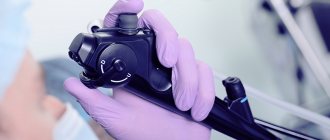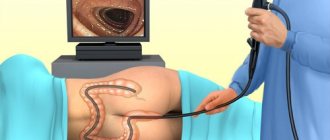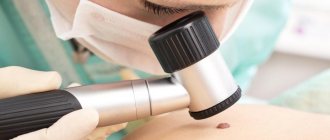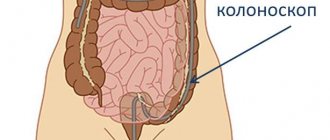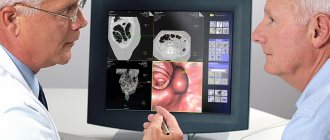- Home /
- Branches /
- CT scan /
- Colon CT (virtual colonoscopy)
Modern computed tomography allows using a 3D model to display the loops of the large intestine.
Compared to endoscopic colonoscopy, this procedure is painless and is performed without anesthesia. CT scan of the intestine requires moderate distention of the intestinal loops, so the patient may experience minor discomfort and the urge to defecate. Virtual colonoscopy is indispensable for Crohn's disease, a disease in which there is a high probability of damage to the intestinal wall by the endoscope. The main advantages of the virtual colonoscopy technique are speed and accessibility, detailed 3D visualization of the entire large intestine with high-quality display of its loops and other organs of the abdominal cavity and retroperitoneal space (liver and bile ducts, kidneys and adrenal glands, pancreas, spleen), vessels and bones on level of research, layer-by-layer viewing of structures of interest in all planes.
Indications for virtual colonoscopy
- Gastrointestinal bleeding;
- colon polyps;
- colon cancer;
- suspicion of nonspecific ulcerative colitis, Crohn's disease;
- abnormalities in the development of colon loops;
- injuries;
- unsatisfactory or questionable data from other diagnostic methods;
- planning surgery on the large intestine;
- monitoring the effectiveness of treatment.
Broad-based intestinal polyp identified on virtual (CT) colonoscopy. The study was performed by M.A. Petrova, a radiation diagnostics doctor at the KGNY.
How is a virtual colonoscopy performed?
Although the procedure is non-invasive, preparation for the study is required in the same way. First, the patient adheres to the rules of a slag-free diet for 3-5 days, and then cleanses the organ the day before with a special laxative. A CT scan is done when the intestines are empty; this is the only way to obtain reliable results.
Procedure during a virtual colonoscopy:
- The patient changes clothes. The lower part of the body is left open, so it is convenient to wear shorts or panties for a colonoscopy. They are sold at the pharmacy.
- The person is placed on the tomograph bed on his side with his knees bent.
- The anus is treated with antiseptics.
- The tip of a special pump is inserted into the anus.
- Fill the organ with gas (carbon dioxide). Use a volume of 3 liters.
- The couch is rolled into the tomograph so that the scanner is located at the level of the abdomen.
- They check using CT whether the intestinal walls are sufficiently straightened, and if there is a shortage, add gas.
- Pictures are taken, and at times the subject is asked to change his body position.
- At the end of the procedure, the doctor uses a gas tube to relieve the patient of the artificially created bloat.
- Within 20-60 minutes, the program processes the results and the person is given a disk with a recording of the diagnosis.
Attention! High-quality bowel cleansing before tomography is more important than preparation for colonoscopy. Since the remains of digested food on a CT scan can be mistaken for a tumor.
Preparing for the study
Carrying out a virtual colonoscopy requires careful preparation; it is best to do it in the morning. On the eve of the study, the last meal is allowed at 14:00; starting from 16:00, take the laxative Fortrans or Lavacol (each sachet for 1 liter of water, for body weight > 70 kg, take 3 sachets, for
Before the study, you must follow a slag-free diet for 3-4 days: exclude legumes, brown bread, chocolate, fresh milk, fresh and pickled vegetables and fruits.
During the period of preparation for the study, take medications prescribed by your attending physician according to the usual (prescribed) regimen.
To improve the quality of the conduct and description of the study, you should provide the results of ultrasound, CT or MRI, which the patient underwent previously, as well as, if available, other medical documents and extracts.
If it is necessary to administer a contrast agent, blood should be donated for biochemical analysis to determine the level of urea and creatinine. This can be done immediately before the test in our hospital ( express tests ) or you can bring the results of a biochemical blood test no more than 2 weeks old.
To obtain the most accurate result, before the procedure it is necessary to remove jewelry, clothing with metal fittings and/or thread, belts and other items containing metal from the abdominal area.
Preparing and performing a virtual colonoscopy?
Before performing the examination, the patient must undergo special training 2 days before the scheduled date. Its essence lies in the complete cleansing of the intestines from toxins, which is achieved by maintaining a diet and taking medications with a laxative effect.
2 days before the examination you will need to give up grain bread, bran, muesli, fruits, berries, jam, beans, nuts, cereals, mushrooms and seaweed. You will also need to drink at least 2-2.5 liters of water daily. The evening before the procedure, the patient needs to drink 2 sachets of Fortrans, which must be dissolved in 2 liters of water. The resulting mixture is drunk within 2-4 hours. On the day of the manipulation itself, eating is prohibited, you can only drink. Also, 3 hours before colonography, you need to drink 60 ml of a solution of iodine-containing contrast agent (Urografin), which provides better visualization.
After preparation, the doctor proceeds to the diagnosis itself, which proceeds in several stages:
- The patient is placed on a special table around which the tomograph is located. During the examination, the apparatus ring constantly rotates around, and the table on which the person lies moves in a horizontal position.
- The patient takes a stationary position, which was prescribed to him by the attending physician.
- The main task of the subject is to maintain immobility throughout the entire procedure. As a rule, it lasts 15-20 minutes. During its implementation, a person does not experience pain or discomfort, and immediately after completion can go to the ward or home.
Alternative methods for diagnosing the large intestine
- Plain radiography of the abdominal organs - determination of colonic obstruction.
- X-ray irrigoscopy - diagnosis of tumors and inflammation, polyps, abnormalities of the large intestine. During the procedure, a mbarium-containing substance is used.
- Ultrasound of the abdominal cavity and pelvis are common screening methods. CT is more informative.
- An MRI of the abdominal organs is performed to clarify the diagnosis and requires special bowel preparation.
- Traditional endoscopic colonoscopy also examines loops of the colon, but requires anesthesia and risks damaging the intestinal wall. Unlike virtual colonoscopy, it allows you to evaluate the appearance of its mucous membrane and take tissue for morphological examination under a microscope.
You can see prices for services
Preparing for a CT colonoscopy
| Diet for 3 days | Exclude:
| You can eat:
|
| Diet the day before | Exclude:
| You can drink:
|
| Keep in mind |
| |
Schemes of drug preparation for CT colonoscopy/FCS
| Dosage | Does not depend on mass:
| |
| Breeding | Each pair of sachets (sachet A+B) is diluted in one liter of still water | |
| Chair markings | Important! Add 20 ml of any of the following drugs to the last liter of solution: Urografin, Trazograph, Omnipaque, Ultravist, Xenetics or Optirey (sold in the pharmacy chain) | |
| Reception scheme |
| |
| Time of receipt | On the eve of the study from 16.00 to 20.00 - take Moviprep solution, liquid food is allowed | |
| Effects | Painless, loose stools appear 1-2 hours after the start of treatment. The stool will turn into a clear or slightly colored liquid 2-3 hours after taking the last portion. | |
WHAT IS A VIRTUAL COLONOSCOPY?
This is an innovative, alternative way to examine the colon without using an endoscope. It is performed using the latest multislice computed tomograph. Today, the Bolnichnaya Clinic has the only apparatus in Tomsk that allows performing studies of this kind.
PAINLESS virtual colonoscopy is performed without inserting an endoscope;
FAST procedure takes only a few minutes;
SIMPLY no special preparation is required: it is enough to follow the standard recommendations, the same as for a regular colonoscopy;
INDICATIONS FOR VIRTUAL COLONOSCOPY
The main indication for virtual colonoscopy is total screening (search) for polyps and other formations of the colon. Polyps are benign tumors that grow from the inner lining of the intestine. Some polyps in the process of growth, if left untreated, become malignant and progress to the stage of oncology. The purpose of screening virtual colonoscopy is to identify polyps at an early stage so that they can be removed before cancer develops.
COLONOSCOPE IS RECOMMENDED:
- persons of mature age (40 years and older)
- persons at risk (if there is a family history of cancer)
- if the work involves radiation or other harmful effects on the body;
- patients who experience frequent bowel movements, anemia, sudden weight loss, or an unexplained rise in temperature;
- if there are contraindications to endoscopy
COLONOSCOPY IS MANDATORY IF:
- blood in stool
- frequent constipation
- abdominal pain of unknown etiology;
- increased flatulence.
As well as persons at risk (colon cancer or polyps in close relatives)
HOW IS A VIRTUAL COLONOSCOPY PERFORMED?
Spiral colonoscopy uses X-rays: a spiral scan occurs, the rays are captured by a sensor, and the resulting signal is processed by a computer.
In a few minutes, the tomograph generates a 3D model of the abdominal and pelvic organs, while the doctor can move the image “inside the intestine” (as with a regular colonoscopy, when the endoscope moves inside the intestine).
The patient lies down on a diagnostic couch, which slides inside the tomograph. A small tube is inserted into the patient's rectum to a depth of about 5 cm. A small amount of air is supplied through this tube into the rectum - this is necessary to improve the quality of the image and straighten the intestine. A scan is performed and the patient is asked to hold his breath from time to time.
The whole procedure takes about 5-10 minutes . Virtual colonoscopy does not cause pain; there may be slight discomfort from distending the rectum with air. As a rule, description of images takes about 30 minutes. All results are recorded on DVD or CD, which is given to the patient along with the conclusion
Unlike conventional colonoscopy, virtual colonoscopy does not require the use of anesthesia.
In situations where a diagnosis is made for an unknown formation, and it is necessary to take a biopsy, virtual colonoscopy of the intestine cannot be a complete replacement for endoscopic colonoscopy.
Colonoscopy. Preparing for the study
More questions and answers about colonoscopy
To summarize, what is better: virtual or real intestinal diagnostics?
Colonoscopy is considered the gold standard of medicine. This is the name given to those research methods that give the most reliable results. By the way, the accuracy of the diagnosis with this method of research exceeds 90%. Much also depends on the quality of preparation and cleanliness of the intestines.
CT does not have such undeniable advantages, but can be useful for preventive diagnostics when there are no direct indications for colonoscopy. Or if a real examination of the patient’s intestines is excluded.
It is not necessary to endure pain; today the procedure is performed under sedation. This is a light anesthesia, in which, without risks or complications, the person sleeps and feels absolutely nothing.
Calculation of diagnostic costs based on patient reviews
An important factor is economic benefit. Today, prices for medical care are quite high, and for most citizens, the ability to spend less is of decisive importance.
Here are some facts about costs:
- Virtual diagnostics cost patients from 3 to 12 thousand rubles;
- Colonoscopy from 1050 to 7500;
- Endoscopic examination under anesthesia from 5 to 18 thousand.

If you search well and also take advantage of the discounts that many medical centers regularly offer, then you can undergo a real examination of the intestines, even under sedation, for about the same money as a CT scan. But if the patient initially goes for a tomography, then in most cases he will still be sent for a regular colonoscopy. In such a situation you will have to pay twice.
It is worth noting that CT scans are not performed free of charge, quotas are provided, but there must be strong indications for the procedure and you will have to wait in a huge queue for several months. At the same time, a regular colonoscopy is carried out free of charge under the compulsory medical insurance policy, but without anesthesia. He will have to pay for it.
Interesting fact! According to patient reviews, many underwent colonoscopy without anesthesia without feeling any pain.
Doctors' opinions on virtual colonoscopy
Of course, a radiologist who directly works in a CT room will tell you about the many advantages of the method. And he will be right. But first of all, when examining the intestines, it is more correct to start from how informative the results of virtual diagnostics are in comparison with a real colonoscopy.
Proctologists who directly deal with intestinal problems still recommend undergoing an endoscopic procedure, since this option has the following advantages:
- The camera sees the mucous membrane “with its own eyes.” They detect areas of inflammation, cracks, necrosis, squamous cell carcinoma, ulcers and other problems;
- Polyps are visible even in tiny sizes, unlike virtual CT;
- The formation is immediately removed, and a biopsy of atypical tissue is also performed;
- A real colonoscopy is the only way to prevent colon cancer today. Since a polyp can develop into a malignant tumor.

Tomography also has advantages:
- Examination of the intestines from the outside, as well as surrounding organs, where the cause of the malaise may lie;
- If the patient does not have serious problems in the specified organ, then virtual diagnostics helps to ensure the absence of pathologies without endoscopic intervention;
- CT scanning is not painful at all, but it is unpleasant when the cavity is pumped with gas.
Attention! Previously, we already considered the question of whether MRI or colonoscopy of the intestines is better.
Patient reviews
In positive responses, people note the absence of negative impressions and the receipt of a decent research result. This opportunity was especially pleasing for those who had already had 1, 2, or 3 real colonoscopy procedures poorly.
Negative reviews make several specific claims:
- After diagnosis, the stomach hurts, bloating persists for a long time;
- Requires complex preparation;
- It was painful while the intestines were filling with gas;
- Tomography of the abdominal cavity gives a very high level of radiation exposure (specialist note: although the indicators are impressive, they do not exceed the permissible limit);
- The reliability of the results is significantly inferior to endoscopy;
- If problems are detected, you will still have to do a colonoscopy;
- Expensive, and adding the previous point means double spending.
For example, a quote from a patient’s review:
“The radiologist saw a large tumor where there was definitely nothing during a regular colonoscopy. When I mentioned this, he replied that perhaps there was a fragment of food left. What kind of reliability of the study can we talk about then? Moreover, the diagnostic report recommends a colonoscopy with biopsy.”
Most patients seek to replace the invasive procedure with computed tomography or magnetic resonance imaging, ultrasound and other methods because they are afraid of pain. But colonoscopy under anesthesia is absolutely safe and devoid of any negative sensations. And as a result, you will receive the most reliable diagnosis, and, possibly, get rid of polyps.
